All You Need to Know Before Buying a Weighted Vest
Author:
Reviewed by:
(21 years of Oly Lifting experience)
Unlock your full potential by engaging with our experts and community! Have questions about your fitness journey or looking for expert advice on weightlifting techniques? Don’t hesitate — leave a comment below and Ihor Shymechko will provide a personalized answer and insights to help you reach your goals.
Torokhtiy is reader-supported. Some links are affiliate links, and we may earn a commission at no extra cost to you. See our disclosure page for details.
If you’re looking for a weighted vest, then chances are that you’re in the realm of intensified workouts. And also, you’ve come to the right place to meet your needs. A weighted vest can be a game-changer – it willa dd extra resistance to your exercises and help you build strength, endurance, and even improve your cardio workouts.
A weighted workout vest isn’t just some random piece of fitness gear, oh no. It is a lifestyle. And out of all the many vests out there on the market, you’re here because you are looking for the best one. But before you decide to buy a new one, there are a few very important factors to consider so you can be sure you’re getting a vest that will work for you.
And that’s exactly what we’ll be doing today – we will cover everything you need to know about weighted vests, as well as what to pay attention to when buying one.
Let’s dive into the world of weighted vests!
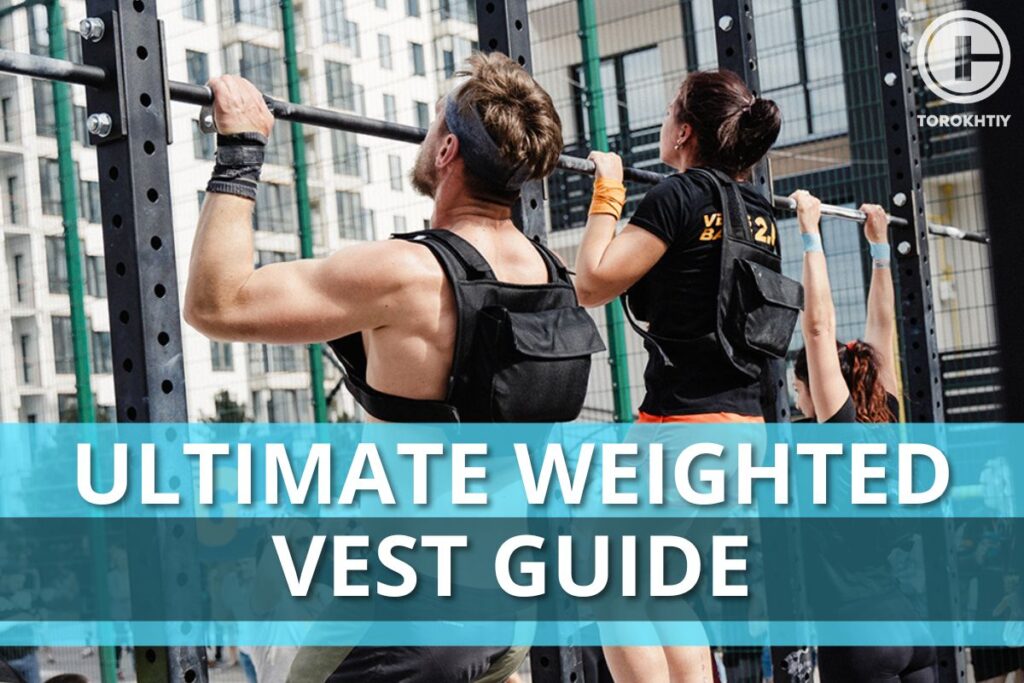
What Are The Benefits Of Wearing Weighted Vests?
✅ Burns More Calories
One of the best benefits of wearing a weight vest is that it can help burn more calories. The reason is simple. You’re exerting more energy when you’re performing your typical workout with an addition of a weight vest.
The more energy you expend, the more calories you burn. That’s why doing cardio with a weight vest can be great for you as you can burn more calories in a shorter period of time compared to doing cardio without a vest.
✅ Versatility
Lastly, a weighted vest is simply a great tool to add more versatility to your workout program. Whether you’re trying to improve your cardio, increase your strength, or build muscle, progressive overload seems to work best.
Meaning that on a weekly or bi-weekly basis you’re either increasing your sets, reps, or weight and maybe even a combination of two or all three of them. So, a weighted vest can be seen as an additional tool for progressive overload.
For example, maybe you’re plateauing with your cardio gains, you can try throwing on a weighted vest for the next block of your cardio session and see if it helps you improve. The same goes for strength or muscle gains.
Vests also come with attachment options such as a place to attach a parachute for sprinting. These types attachments can further enhance your workout and provide you with more versatile options.
✅ Increases Strength
A weight vest is also great for increasing strength. In particular muscle and bone strength. When you wear a vest, you’re essentially adding weight resistance to all of your body.
By just wearing it, you’ll be engaging your core, your lower body will have to walk around with a larger weight than it’s previously used to, and your upper body will have to adapt to the new resistance as well. All of this can result in muscular gains, an increase in bone density, and overall strength.
✅ Time Efficient
Another benefit of a weight vest is that it can make your workouts time efficient. Instead of doing an hour-long cardio session, you could get away with just half the time with a weight vest because your body will be expending more energy.
Or, instead of having to do a ton of sets and reps for your bodyweight exercises to get the maximum amount of gains, you can do much less and increase the intensity of your workout with a weight vest and get similar benefits.
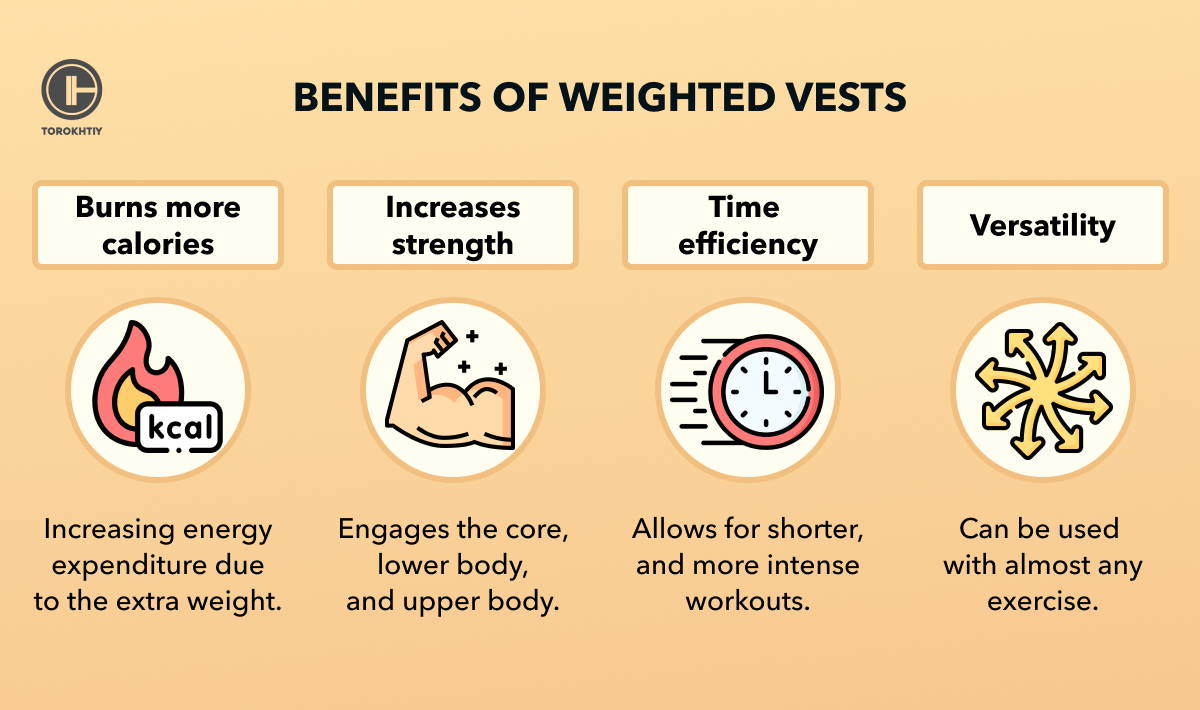
When Do You Need A Weighted Vest?
1. For Bodyweight Exercises
Bodyweight workouts like dips, push-ups, and pull-ups, are very popular and effective. However, one drawback they can have is that it’s difficult to progress in them over time. Eventually, doing 100s of push-ups for your workout is not time efficient. It is also difficult to properly add weight to these bodyweight exercises.
That’s why a weighted vest can be very useful because it naturally fits over your shoulders and chest and feels like a part of your body. This can allow you to keep progressing in these types of workouts.
2. Low-Impact Cardio
Low-impact cardio like a long hike or a walk or a light jog is perfect for a weighted vest. Not only do you add resistance that forced your body to adapt and adjust thus increasing your muscular and bone strength, but you can also burn more calories in a shorter period of time. So, you get the best of both worlds.
Also, as mentioned above, a weighted vest can be the perfect tool to keep your progression going without increasing the time you spend doing the activity. So, instead of a 3-hour hike, you can perhaps to a 2 or 2-and-a-half-hour one with a weighted vest and get the same benefits.

3. Unilateral or Agility Exercises
Unilateral work can be incredibly important for addressing muscular imbalances and targeting specific muscles.
But when it comes to your lower body, it can be difficult to properly do unilateral work because you have to focus so much energy on balancing on one leg while holding a weight in your hands.
For example, an exercise like Bulgarian split squats can be awkward for many as they find themselves tilting forward due to the weight in their hands. Instead, you can simply use a weight vest and take out the balance part, so you can fully focus on your muscle.
Agility exercises have a similar issue as well. Doing material drills or jumping exercises with weights like dumbbells can be difficult and could lead to injuries if you land improperly. But with a weight vest, the drills can be performed smoothly while minimizing the risk portion.
4. Physical Limitation
One of the best benefits of a weight vest is that it can be used by a wide variety of individuals. If you have an injured wrist or forearm or have hurt any muscle in your arms, it could be difficult to workout properly. But you can still wear a weighted vest and stay healthy as you recover.
In the same vein, if you have a physical disability that prevents you from holding weights, you can use a weight vest instead to keep challenging yourself and making strengthen and cardio gains.
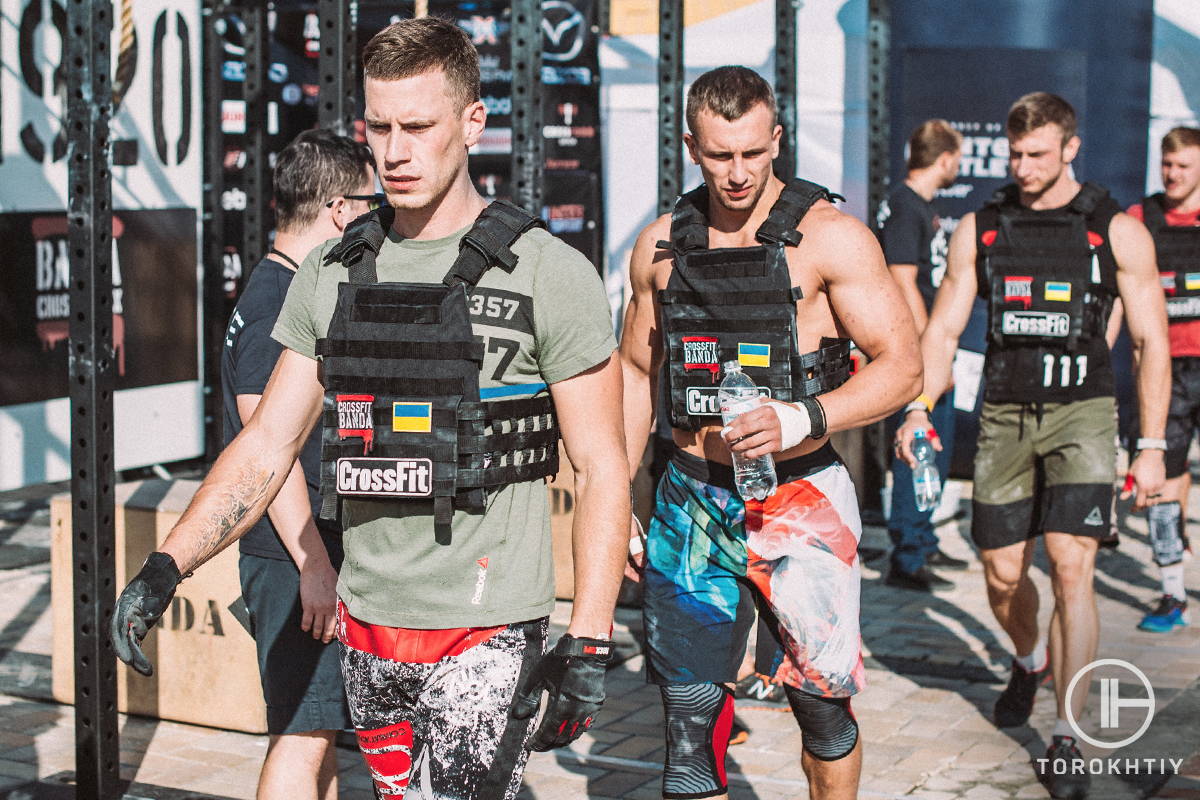
5. Grip Limitations
Grip strength can be a weak point for a lot of people. This can lead them to pick weight that matches their grip strength rather than their overall strength. For example, with an exercise like farmers’ walk, you might be able to handle more weight, but can be limited to the amount your grip can carry.
In such cases, having a weight vest can be a great option as your body can carry much more weight than your grip.
This also is true for exercises like lunges, which not only are limited to your grip strength but also your coordination and balance. But both coordination and balance are easier to achieve when the weight is spread equally over your torso, as it is with a weighted vest.
Our expert Sergii Putsov shares:
“No! Weighted vests are not just adding extra resistance. Absolutely not! There’s much more to it than just that. You see, when I strap on my vest, it’s not just for the extra muscle burn while running, push-ups, or pull-ups. What the weight vest does is, it fires up my cardiovascular system.
If you’re looking to increase how much calories you’re burning, then I’ve got two words for you: Weighted vest. But don’t forget that you can’t overdo with the added weight. Listen to your body and keep your posture rock-solid. Safety first, after all!”
6. Unleashing the Power of Plyometrics with Weighted Vests
If you include a weighted vest in plyometric training, it can take your workout to a whole new level. Plyometrics focuses on explosive movements, so when you add a weighted vest to it, the workout becomes so much more effective.
A weighted vest will make the workout more challenging because of the added resistance and will engage more muscle fibers. Say you’re doing box jumps or burpees – with the added weight, your body will need to produce more energy to complete them. The resistance from the vest can improve your overall fitness, and it’s especially beneficial for sprinting speed.
Of course, you need to start slow, with lighter weights, because the extra load will place pressure on connective tissue and joints. Before you decide to add a vest, make sure you have a solid foundation in plyometrics.
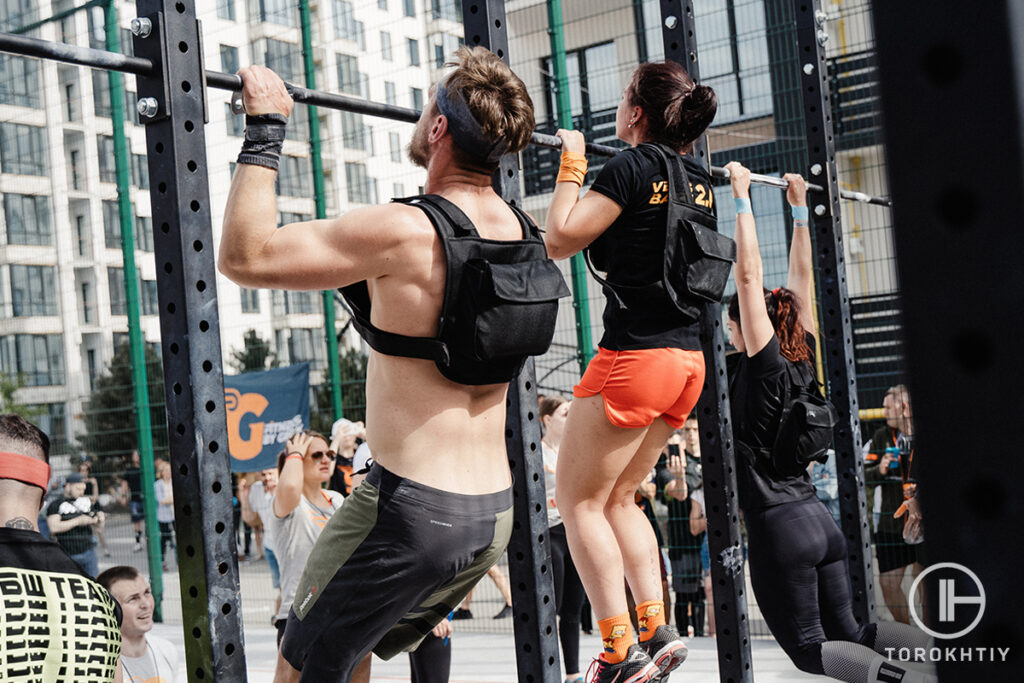
4 Types of Weight Vests
1. Metal Plate Loaded
These types of vests are designed to be loaded with specially designed metal plates (usually in a rectangular shape with the top side being curved).
They have dedicated secure fitting for the plates (usually one in the front and one in the back), which in turn allows the user to easily add/remove the weight plates, which typically weigh 2.5, 5, and 10 lbs (although different weights aren’t uncommon).
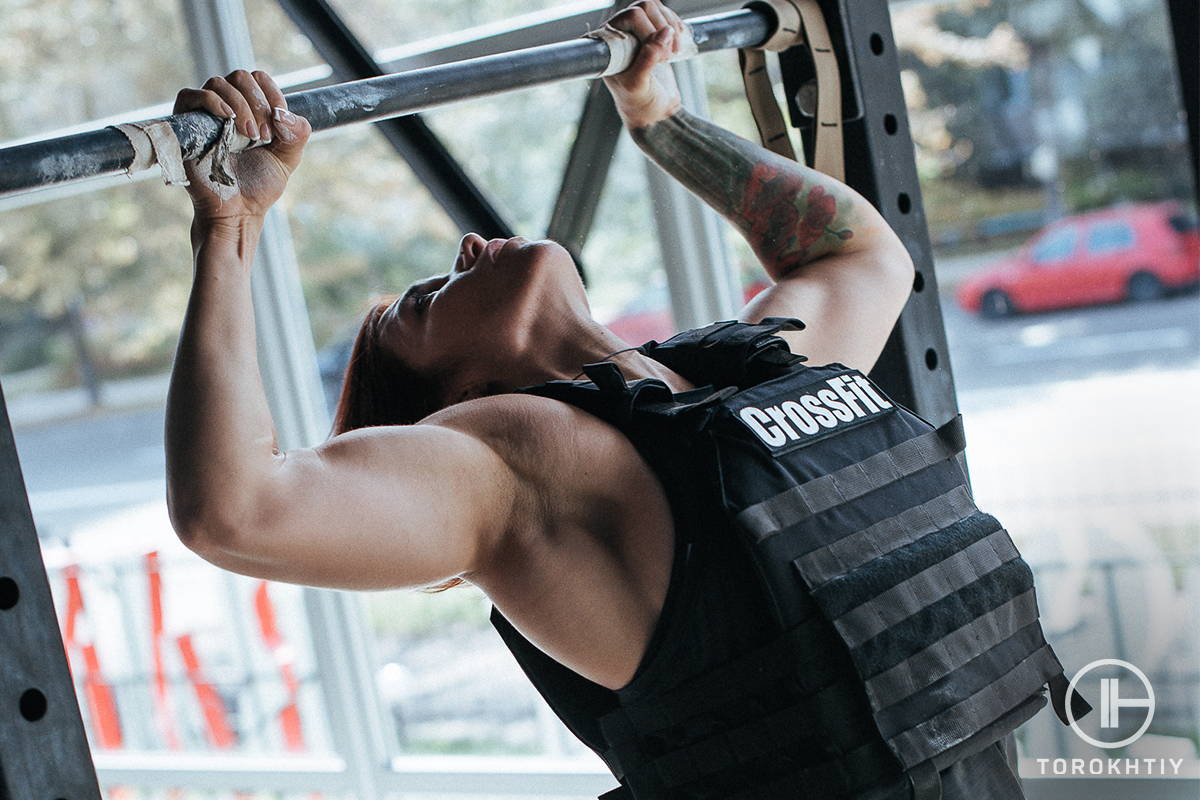
2. Weight Packet Loaded
These weighted vests have a number of small pockets that are designed to be filled with small weights (e.g., small metal bars, sandbags, iron sandbags). This way, the user has much better control over the total weight that will be used. The weight is added/removed in small increments.
The weight of the metal bars, sandbags, and iron sandbags is typically in the range of 0.5-2 lbs. While gaining control, users of these types of vests usually lose in terms of stability, as these many weight-filled pockets increase the wobbling and movement of the vest itself (this is not always the case though).
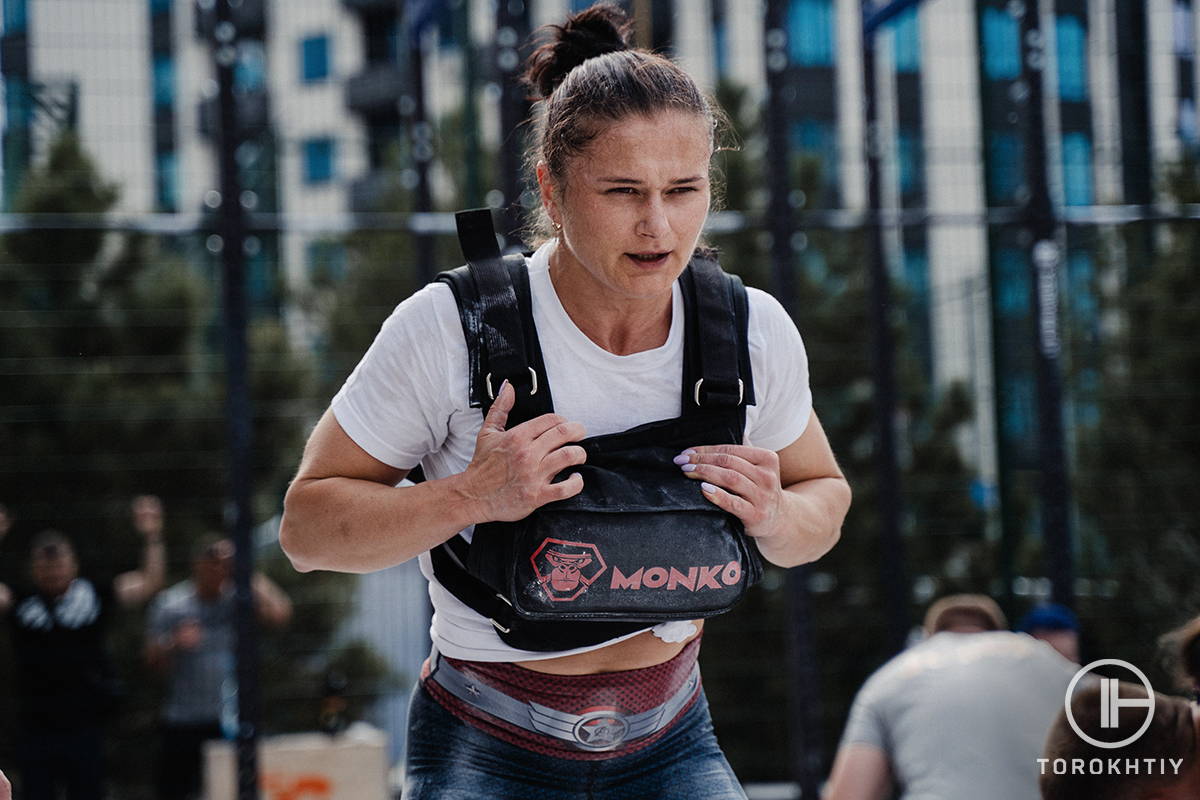
3. Barbell Plate Loaded
The barbell plate loaded vests are designed to do as the name suggests – to be loaded with barbell weight plates. They usually have a peg/sleeve (one in front and one in the back) onto which you’ll load a barbell plate (or plates), and screw them securely in place with a collar/clamp or screw-on cap.
The amount of weight plates that you can attach depends on the lengths of the sleeve, which is usually between 4-8 inches long, and the width of the weight plates.
Most of these types of weighted vests can be used with any type of plate (standard 1’’, or Olympic 2’’), even though they might require a specialized add-on in order to be used with both. Some barbell-loaded vests require specially designed plates.
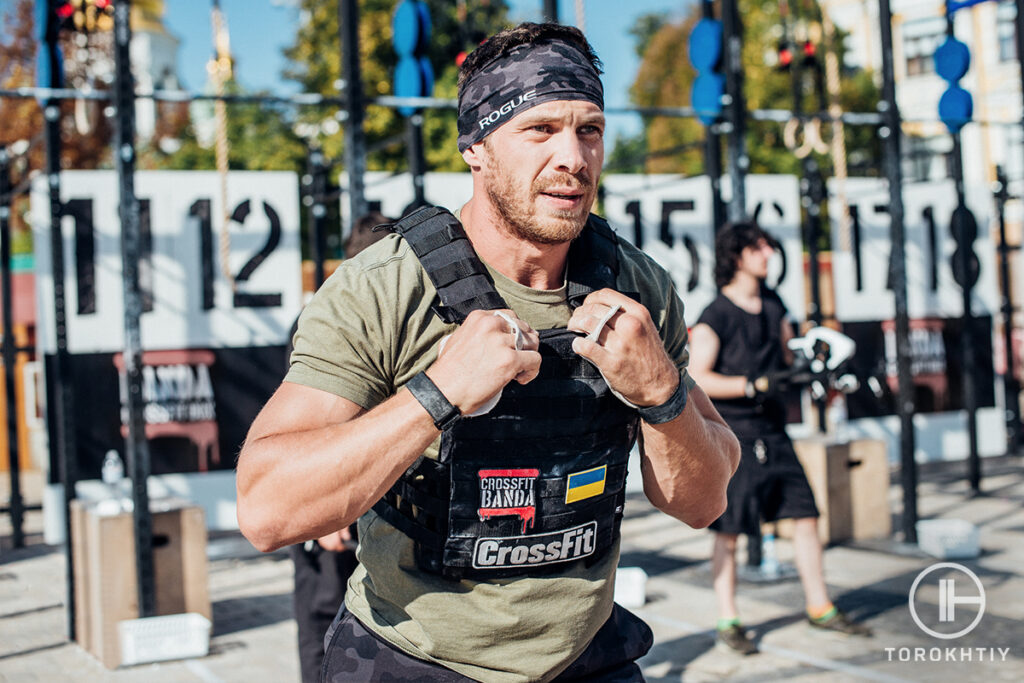
4. Fixed
Fixed weighted vests come with the amount of weight already determined and it’s sewn into the vest itself. If you don’t want to deal with adjusting the weight and already know how much resistance you want, these are a good choice. Overall, they’re ideal for cardio and bodyweight workouts.
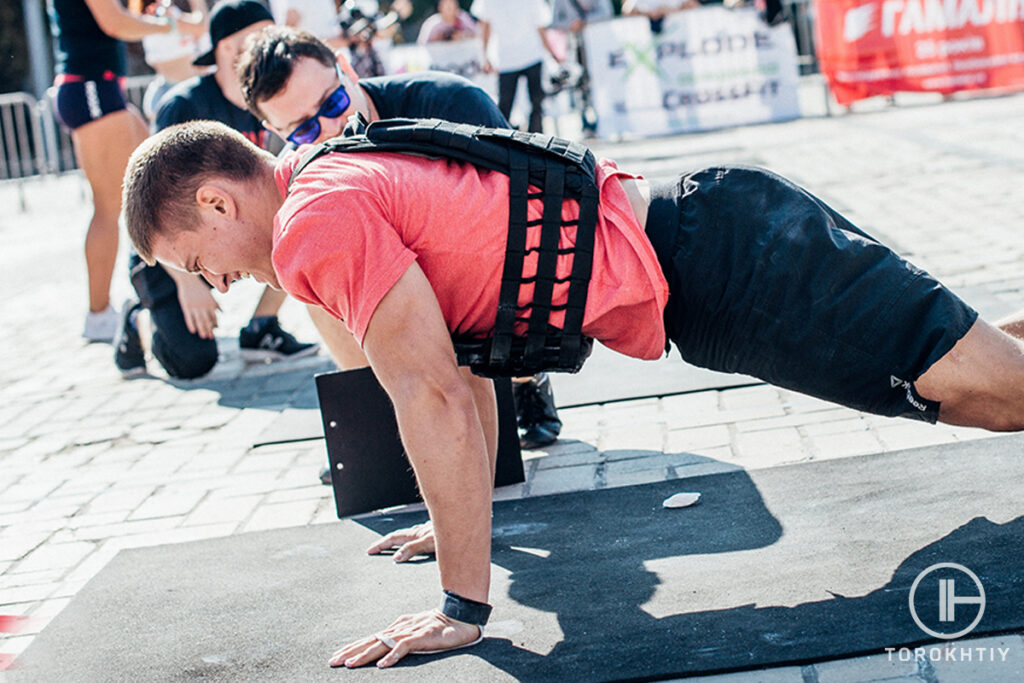
What To Look For In Weighted Vests?
1. Price/quality
The price and quality of a weight vest vary greatly. You can purchase one for as low as $30 or as high as $300. This price range depends on various factors like quality, versatility, plate-loaded or not, and design just to name a few.
If you’re not sure that you need a weight vest, you could try using weighted backpacks for hikes and walks and see how you feel. If you find them to be beneficial, then making an investment into a weight vest can be worth the price.
2. Design
Weight vest designs can also vary a lot. You will be able to pull over most weight vests like a t-shirt. This way the vest rests on your shoulders and chest. Otherwise, weight vests can have a belt strap that you tighten around your torso after putting on the vest.
The design also dictates how you load your weight vest. Certain vests come with numerous small pockets in which you can place weights to increase the overall resistance. While others are designed to carry full Olympic-sized metal plates.
There are also weight vests that are filled with substances like sand and come with a fixed weight. So, in order to increase or decrease weight, you have to change the vest itself.
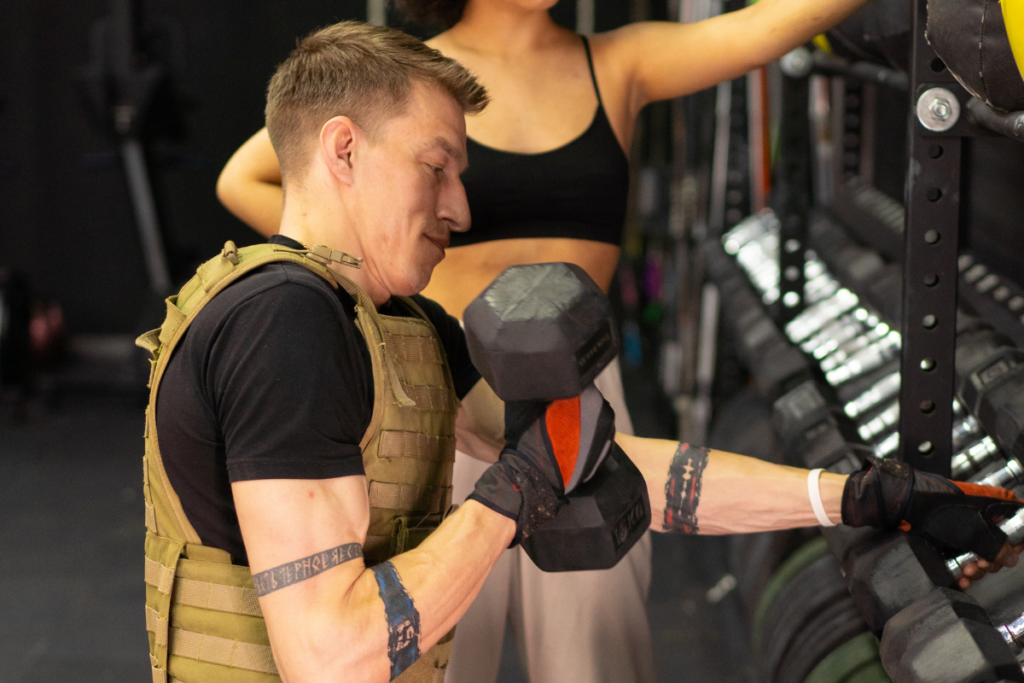
3. Durability
The durability of the weight vest will largely depend on two factors. First and foremost, the material quality of the vest along with any special perks like reinforced stitching. The second factor is how long and how often you wear the vest. Naturally, the more you use something, the sooner it will break down.
Typically, vests are either worn for a short, intense workout, or a long casual cardio session. But if you’re doing several of these sessions a week, you could find yourself needing a new vest sooner than you had hoped.
4. Comfort
Comfort is a big factor when it comes to picking the right workout tool. The last thing you want is something that causes discomfort and distracts you from your actual workout session. Two factors to keep in mind when it comes to comfort are shoulder straps and chest mobility.
A weighted vest will put pressure on your shoulders as you are carrying the weight around. Think of a school backpack with a ton of textbooks inside. So, having some padding on the shoulder strap or a waist buckle to relieve pressure from your shoulders can be great.
While chest mobility is important too so you can breathe properly. You don’t want a vest that is very tight around your chest. This can be dangerous and interfere with your workout.
| Category | Description | Why Is It Important? |
|---|---|---|
| Price/Quality | Shows you how much value you get for the money spent. | Indicates the overall value of the product (money and product longevity), and tells you whether the vest is a good investment. |
| Design | Show you how complicated the vest is to use, put on and take of yourself, and how well it snugs against your body. | Ensures ease of use and aesthetic appeal. |
| Durability | Shows you product longevity. It is determined by the materials used, stitching, quality of craftsmanship, etc. | Longevity and resistance to wear and tear. |
| Comfort | A high comfort level is usually achieved by placing extra padding between your skin and the weighted vest. The higher this number is, the better experience you’ll have during a long exercise. | Critical for prolonged use and reduces the risk of injury. |
5. Material
A vest can be made of many different materials. Some of the common ones are nylon and polyester. But it’s also common for a vest to be made of a combination of different materials like mesh, velcro, and soft padding. Material is especially important as it will largely determine the durability of the product.
You want to ensure if there is a lot of stitching on the product that it is reinforced or has double stitching to enhance longevity. Especially if you’re planning on going heavy with your weighted vest as more weight will put more strain on the stitching.
You also would want to avoid too much velcro if you’re planning on using the vest regularly as velcro can wear out quicker.
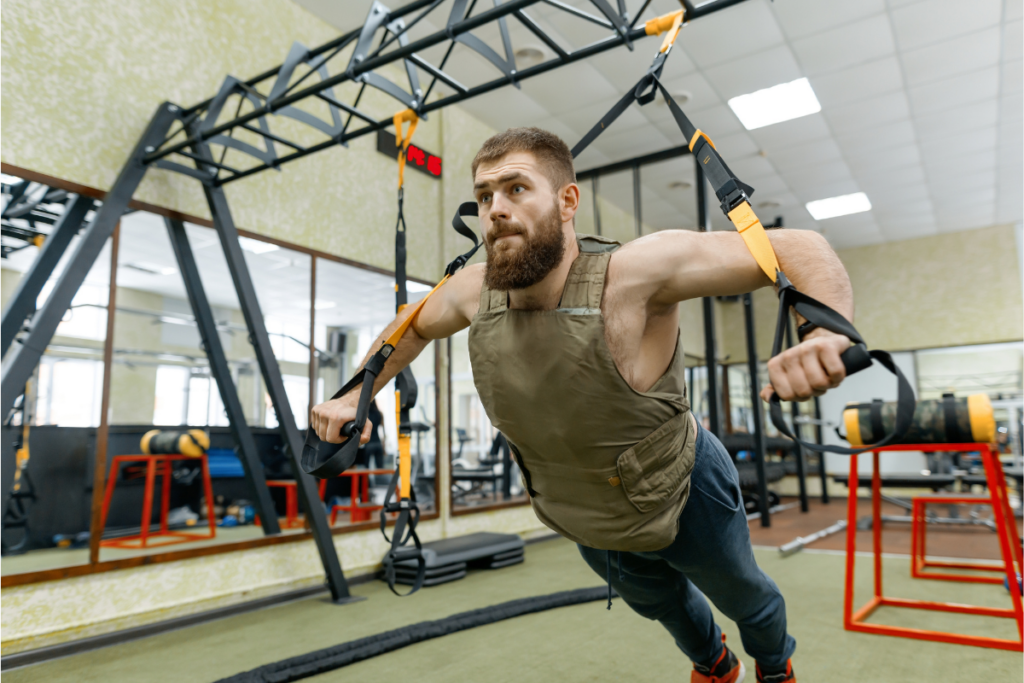
6. Customizable
Lastly, it’s always good to have a customizable product. This can mean choosing between various different color options and settling on the one you prefer. Or it also has to do with personalized attachments to the weight vest in terms of dog tags or patches. Some vests come with these types of options, but that usually means a higher price tag.
Condor Sentry Plate Carrier
We highly recommend the Condor Sentry plate carrier which combines comfort and resistance. It is a plate carrier weight vest that can hold medium and large ESAPI plates within a weight range of 5 to 20 pounds.
While the comfort features include adjustable shoulder straps to reduce pressure, padded mesh lining for more breathability, removable shoulder pads, and a hook-and-loop system to reduce the weight that sits on your shoulders.
The various material used to construct the vest aid the durability of the product, along with making it lightweight. The lightweight nature is further enhanced by the minimalist look of the product as it doesn’t come with any extra or unnecessary bulk.
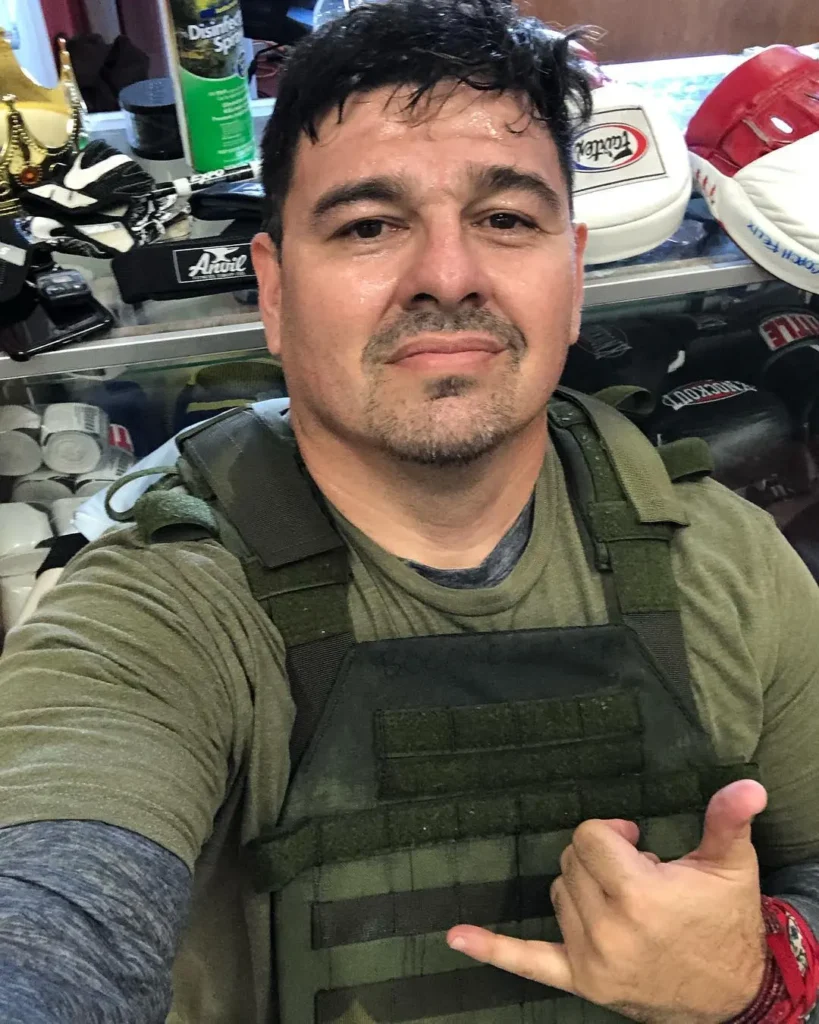
The high-quality vest is reflected in the price of the product, but you’re also getting some custom features like several different color options along with modular attachment options.
Finding Your Ideal Weighted Vest Load
Weighted vests can transform your workouts and add a lot in terms of results. They’re ideal for breaking plateaus and boredom. That is, if you choose the correct one, with the right amount of weight. You may be tempted to add more weight than you can handle, but gradual progression is very important, and too much weight will do more harm than good.
If you’re a man and you’re just starting out with weighted vests, a good place to start is 5-10% of your body weight. So, let’s say you weigh 160 pounds. That means that the sweet spot is anywhere between 8 and 16 pounds of added weight.
If you’re a woman, you can also start with a weight that’s anywhere between 5% and 10% of what you weigh. That may not sound like a lot, but you’ll see that even this amount of resistance can pack a punch. As you get stronger and more used to wearing a weighted vest, you can increase the amount of weight.
Weighted Vest Recommendations Based on Body Weight
| Athlete | Starting Weight (percentage of your total body weight) | Cardio (percentage of your total body weight) | Strength exercises (percentage of your total body weight) |
|---|---|---|---|
| Men | 5-10% | 5-8% | 8-12% |
| Women | 5-10% | 4-6% | 6-10% |
Adjustable weighted vests are best for beginners because you can easily adjust the amount of resistance.
As far as workouts go, you’ll need different weights for different workouts.
When it comes to cardio, it’s important to start with a lighter load. Men can begin with 5-8% of their body weight, while women should start with anywhere between 4% and 6%.
Push-ups, pull-ups, and squats can take slightly heavier loads, so if you’re a man, add about 8-12% of your body weight, or 6-10% if you’re a woman.
Strength training is what can take the most weight, anywhere from 10-15% of their body weight for men, and 8-12% for women. With strength training, it’s good to wear the vest even during warm-up.
Again, these amounts may not sound like a lot, but you need to remember that a weighted vest that compromises your form or causes any kind of discomfort is counterproductive. Although it may not sound sensical, slow progression is what’s going to give you the quickest results.
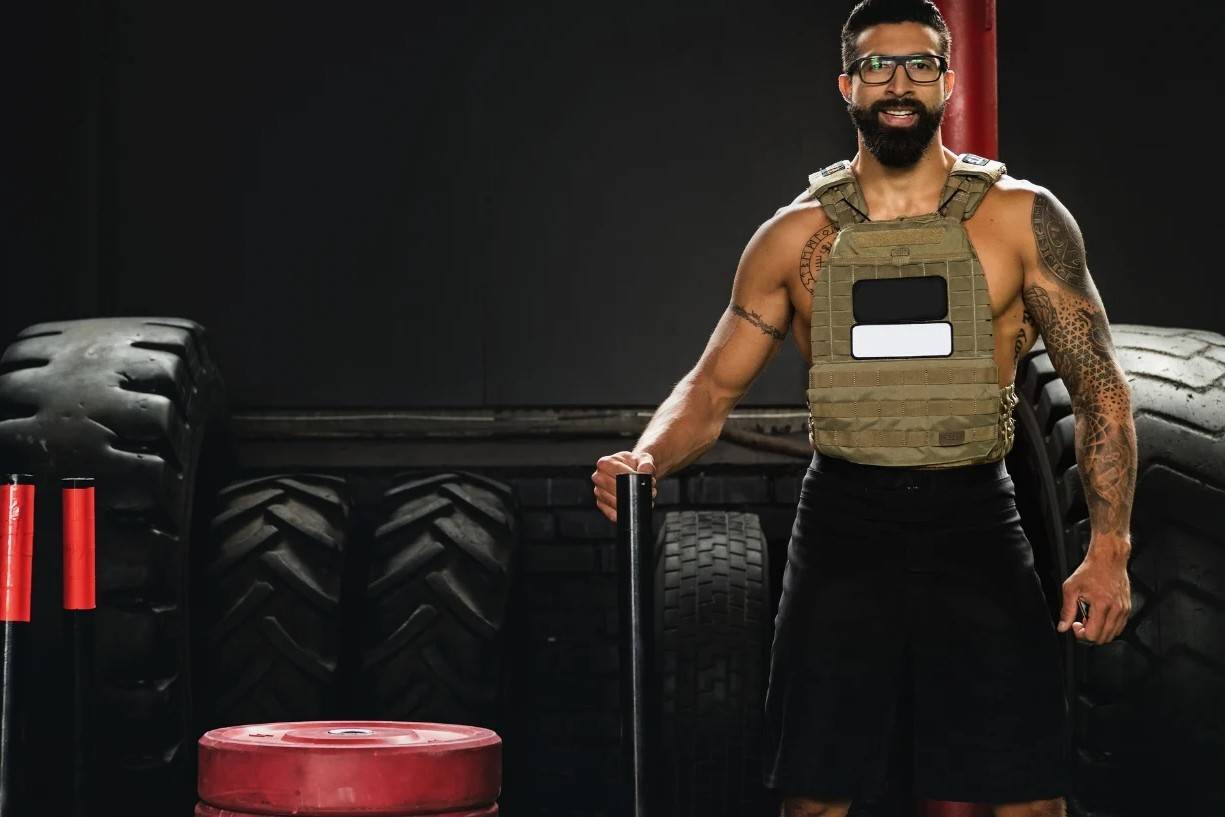
4 Types of Training with Weighted Vests
Weighted vests are a versatile tool that can be added to any training. It doesn’t matter whether you’re pursuing increased agility, or wish to increase the limits of high-intensity intervals. The added challenge often brings rewards. Here are a few training methodologies where using a weighted vest will only upgrade the overall experience.
1. HIIT
HIIT is a super effective workout methodology, and adding a weighted vest to your sessions can only improve it. Combine burpees, sprints, or squat jumps with brief periods of rest, and don’t forget to wear your vest while doing so!
2. Cross Training
This is a methodology that incorporates and blends exercises from a number of different disciplines (e.g., cycling, plyometric drills, strength exercises, etc.). This helps with enhancing overall fitness and helps prevent muscle imbalances. Adding a weighted vest into the mix into this intense routine can only help boost the overall results.
3. Agility Drills
Another workout methodology is Agility Shifts. Lateral shuffles, cone drills, and ladder runs will become even more effective if you add a weighted vest to them. If you add more resistance to these workouts, it will challenge your speed and coordination.
4. Bodyweight Circuit
The last workout methodology that we’ll mention is the Bodyweight Circuit. Combine a few bodyweight workouts into a circuit and wear a vest while working out. For example, you can do push-ups, planks, squats, and lunges (all of which can be done without any additional equipment).
Also, very popular are pull-ups and dips, but these require equipment support in order to be executed. Set a number of reps and do each of the workouts without any rest in between them. This, with the added weight, is going to make your muscles work even harder.
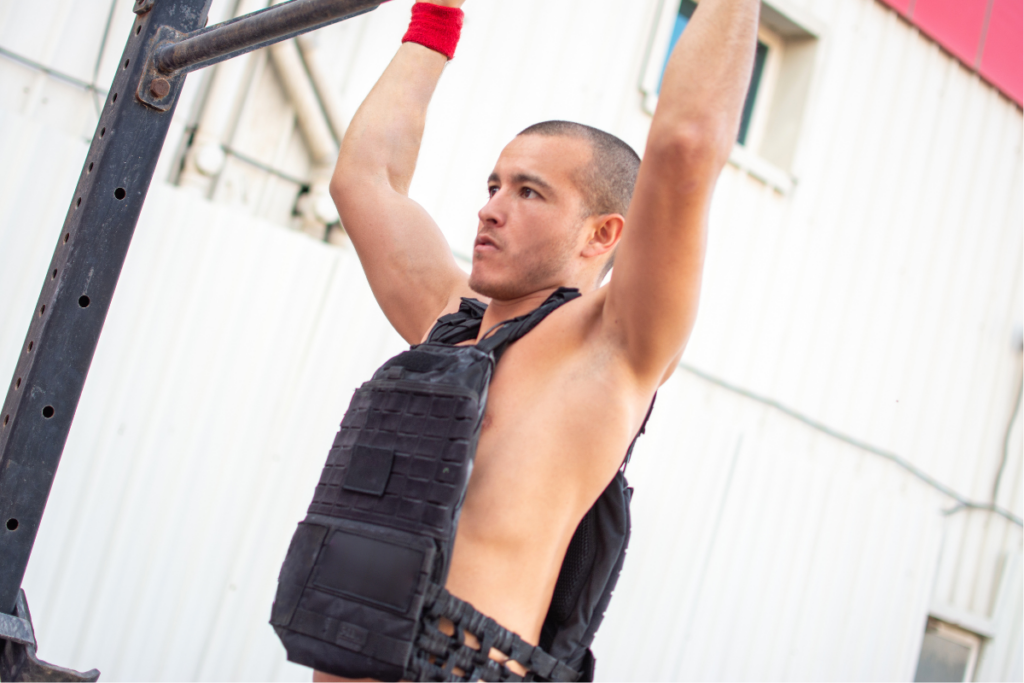
Types of Exercises with Weighted Vests
Introducing a weighted vest into exercises (upper body and lower body) intensifies the challenges, but also amplifies the results. In a way – you are getting more results, faster. This is because your targeted muscles need to work harder to compensate for the added strain that the weighted vests bring.
We can’t list all of the exercises that exist, but we’ll provide a few upper and lower-body exercises for you to see the effects of wearing a weighted vest.
Upper Body Exercises
1. Pull-Ups
Weighted vests have a great synergy with pull-ups as they increase the total weight that you have to lift otherwise. By wearing a weighted vest, you’re adding to the workout intensity and will increase the work your lats/biceps/core have to do. This is great for increasing endurance over time and building muscle mass.
2. Push-Ups
While doing a push-up, as you lower and raise your body, the additional weight from the weighted vest will place more stress onto your chest muscles, shoulders, and triceps. This promotes muscle growth and increased strength in your upper-body region.
Lower Body Exercises
1. Running
If you’re looking to a weighted vest might be a great option. The added weight from a weighted vest increases the forces that are being placed on the leg muscles with each passing stride. This is amazing for your overall cardio fitness, stamina, and leg strength.
2. Air Squats
Regular air squats predominantly focus on your quadriceps, glutes, and hamstrings. Adding a weighted vest to the mix will place additional resistance that these muscles have to overcome.
3. Jumps
Weighted vests also increase the difficulty rating of simple exercises such as vertical jumps or broad jumps. The added weight from the vest forces your leg muscles to exert more force than usual, thus leading to increased explosiveness and overall lower body strength.
4. Stair Climbing
This one is super simple because all you need to do is find a set of stairs and go up and down while wearing a weighted vest. Your cardiovascular system will greatly benefit from this added resistance.
5. Box Jumps
Weighted vests can increase the amount of energy your body produces, so if you want to build exploding power in your legs, just add a weighted vest to box jumps. It will add resistance as you jump onto the box, and your muscles will have to work harder to lift your body weight.
4 Types of Workouts with Weighted Vests
Seamlessly adding a weighted vest to a workout routine can be beneficial in a great many ways. There is a myriad of workout routines available, and we won’t cover them all, but we will give you some classic three, starting off with the most popular one – Murph.
1. Murph
For time
- 1 mile run
- 100 Pull-Ups
- 200 Push-Ups
- 300 Air Squats
- 1 mile Run
Wear a weighted vest with 20/14 lbs.
2. René
7 Rounds for time
- ¼ mile run
- 21 Walking Lunges
- 15 Pull-Ups
- 9 Burpees
Wear a weighted vest with 20/14 lbs.
3. Chad
For time
- 1000 Box Step-Ups
Use a 20-inch box.
Wear a weighted vest with 45/35 lbs.
4. Cardio
Enhance your cardio routine by incorporating a weighted vest. It’ll add a new dimension to your workout. Running, jogging, hiking… Adding a weighted vest to any of these will up your heart rate, improve performance, and burn even more calories.
2 Complete Workout Plan Examples
If you are looking for a complete workout plan, here are two examples:
1. Cardio Weight Vest Challenge
Duration: 20 minutes
Instructions: This is an interval workout. Do your warm-up first, then start the challenge. Perform each exercise in the workout at high intensity for 30 seconds, followed by a 30-second rest. Do 4 rounds of the complete challenge. During the workout, keep your core tight and remember to breathe.
- High Knees: Run in place, raising your knees as high as possible.
- Mountain Climbers: Start in a plank position. Drive your knees, one at a time, towards your chest (as if you were climbing).
- Jumping Jacks: Start in a standing position, with your feet together and hands by your side. Jump your feet out while raising your arms, then jump back to the starting position.
- Box Jumps: Using a sturdy platform (box, steps, elevated flat surface), jump up onto it with both feet, then jump back down.
- Sprint: Find a flat distance with no obstructions where you can run a short distance uninterrupted. Sprint back and forth.
After you complete this workout, remember to cool down. Also, keep in mind to adjust the intensity and the total weight of the weighted vest based on your fitness level.
2. Full-Body Weight Vest Circuit
Duration: 18 minutes
Instructions: Do your warm-up first, then start the circuit. Perform each exercise in the workout at high intensity for 45 seconds, followed by a 15-second rest period. Do 3 rounds of the complete circuit. Allow your body to recover for 1 minute in between each completion of the full circuit. During the workout, keep your core tight and remember to breathe.
- Squats: Stand with your feet shoulder-width apart. By bending the knees, go down as if trying to sit on a chair. Ensure your knees don’t go over your toes. Go back up.
- Push-ups: Start in a plank position. Lower your body towards the ground by bending the elbows, then push yourself back up into the starting position. Keep your body straight at all times.
- Lunges: Stand in an upright position. Take a step forward (with one foot) and lower your body until both knees are at 90 degrees. Push back to the starting position and then do the same with the other leg. That’s one rep.
- Burpees: Start standing. Drop into a squat position, then extend your hands in front of you, to the ground, and proceed to kick your legs back so that you end up in a plank position. Then jump your feet back into a squat, stand up, and jump with your arms overhead.
- Plank: While keeping your body straight (from head to heels), use your forearms and toes as support to keep your body overground. Keep your core tight, and keep this position without letting your hips sag or rise.
After you complete this workout, remember to cool down. Also, adjust the intensity and the total weight of the weighted vest based on your fitness level.
FAQ
Are weighted vests good for training?
It mainly depends on your training goals. If you’re concerned about maximizing hypertrophy and strength, then vests are not ideal. However, for functional strength and progressively overloading certain exercises or your cardio workout, a vest can be a great option.
Also, a vest can be great if you have trouble with coordination and balance as the weight of the vest is more stable and evenly distributed compared to holding dumbbells in each hand.
What is the best weight for a weighted vest?
This will entirely depend on the exercise or workout. Generally, you want to keep the weight lighter for longer cardio sessions. However, if you’re training your lower body in the gym, you could handle heavier weights. You should start off with about 10% of your bodyweight and go from there.
Is wearing a weighted vest worth it?
A weight vest has many benefits which include strengthening your muscles and increasing bone density, to burning more calories and fat during your workout, to adding versatility to your workout program. So, a vest is definitely worth it.
Can wearing a weight vest cause problems?
Like all fitness tools, you do have to be cautious with them. If you wear a vest that is too heavy for you, you could hurt yourself. Or if the vest is too tight and restricts your breathing or puts too much pressure on your shoulders. So, it’s best to get your measurements and picking a vest that meets your dimensions.
Conclusion
A good workout weight vest can help improve your cardio while building muscle and strength in your entire body. These vests should have a stable weight distribution to minimize the risk of injury while being made of high-quality material that can be further reinforced with stitching for a more long-lasting vest.
The vest that best fits this general description is the Condor Sentry Plate Carrier.
What’s your favorite workout to do with a weight vest? What type of weight vest do you prefer? Plate-loaded or pocket weights? What additional attachments do you like on a weight vest?
Let’s discuss all of this and any other questions you might have in the comment section below!
Also Read:
- Weighted Vest Workouts
- Running With Weighted Vest
- Weighted Vest Benefits
- Benefits of Walking With a Weighted Vest
- Weightlifting Shoes Guide
- Kensui Ez Vest Review
- Kensui Swissies Review
References:
- Anthony O’Reilly, “4 BENEFITS OF WORKING OUT WITH A WEIGHTED VEST”, Muscle and Fitness, https://www.muscleandfitness.com/fitness-essentials/4-benefits-of-working-out-with-a-weighted-vest/
- WESLEY DOYLE, “The 10 Best Weighted Vest Exercises for Building Muscle”, Mens Health, https://www.menshealth.com/uk/workouts/g37892000/best-weighted-vest-exercises/ (UPDATED: 08 OCTOBER 2021)
- Michael L Puthoff, “The effect of weighted vest walking on metabolic responses and ground reaction forces”, NCBI, https://pubmed.ncbi.nlm.nih.gov/16679992/ (Accessed 2006 Apr)
- Olfa Turki, “Dynamic Warm-Up With a Weighted Vest”, NCBI, https://pubmed.ncbi.nlm.nih.gov/31094248/ (Accessed 2020 Feb 1)
- K R Barnes, “Warm-up with a weighted vest improves running performance via leg stiffness and running economy”, https://pubmed.ncbi.nlm.nih.gov/24462560/ (Accessed 2015 Jan)
- Timo Rantalainen, “Effect of weighted vest suit worn during daily activities on running speed, jumping power, and agility in young men”, NCBI, https://pubmed.ncbi.nlm.nih.gov/22266642/ (Accessed 2012 Nov)
- “Reduced obesity for weighted-vest wearers”, Sciencedaily, https://www.sciencedaily.com/releases/2020/04/200430091301.htm (Accessed April 30, 2020)
- Andrea J Fradkin, “Effects of warming-up on physical performance: a systematic review with meta-analysis”, NCBI, https://pubmed.ncbi.nlm.nih.gov/19996770/ (Accessed 2010 Jan)
- Photos by Torokhtiy Media Team; photo by Mikhail Nilov, Canva; photo by Valerii Honcharuk, Canva; photo by Jun, Canva; photo by Bojan89, Canva.
Why Trust Us?
With over 20 years in Olympic weightlifting, strength training, nutrition coaching, and general fitness our team does its best to provide the audience with ultimate support and meet the needs and requirements of advanced athletes and professional lifters, as well as people who strive to open new opportunities and develop their physical capabilities with us.
By trusting the recommendations of our certified experts in coaching, nutrition, and sports training programming, as well as scientific consultants, and physiotherapists, we provide you with thorough, well-considered, and scientifically proven content. All the information given in the articles concerning workout programming, separate exercises, and athletic performance, in general, is based on verified data.
The product testing process is described in more detail here.
Author: Ihor Shymechko
Pro Olympic Weightlifter, Coach
Best Results: Snatch – 208 kg,
C&J – 240 kg
Ihor has been a professional weightlifter since 1996, boasting over two decades of competition experience. His notable achievements include clinching the European Championship in 2009 and securing a silver medal in the 105kg division at the Senior World Championships in 2011. Ihor represented his country in the 2008, 2012, and 2016 Summer Olympics. After retiring from competitive weightlifting, he transitioned to coaching, leveraging his vast experience to guide athletes who now compete on both national and international stages.
Reviewed by: Oleksiy Torokhtiy
Olympic Weightlifting Champion, PhD in Sport Science
Best Results: Snatch – 200 kg,
C&J – 240 kg
Oleksiy Torokhtiy is a professional athlete boasting 20 years of experience in Olympic weightlifting. With multiple European and World titles under his belt, he has showcased his prowess in two Olympic Games (Beijing 2008 and London 2012). Upon concluding his illustrious career, Oleksiy dedicated himself to coaching. By 2022, he had conducted over 200 weightlifting seminars worldwide. He is the visionary behind an international sportswear and accessories brand known for its motto, “Warm Body Cold Mind.” Additionally, he is an esteemed author and the creator of a series of training programs and eBooks.




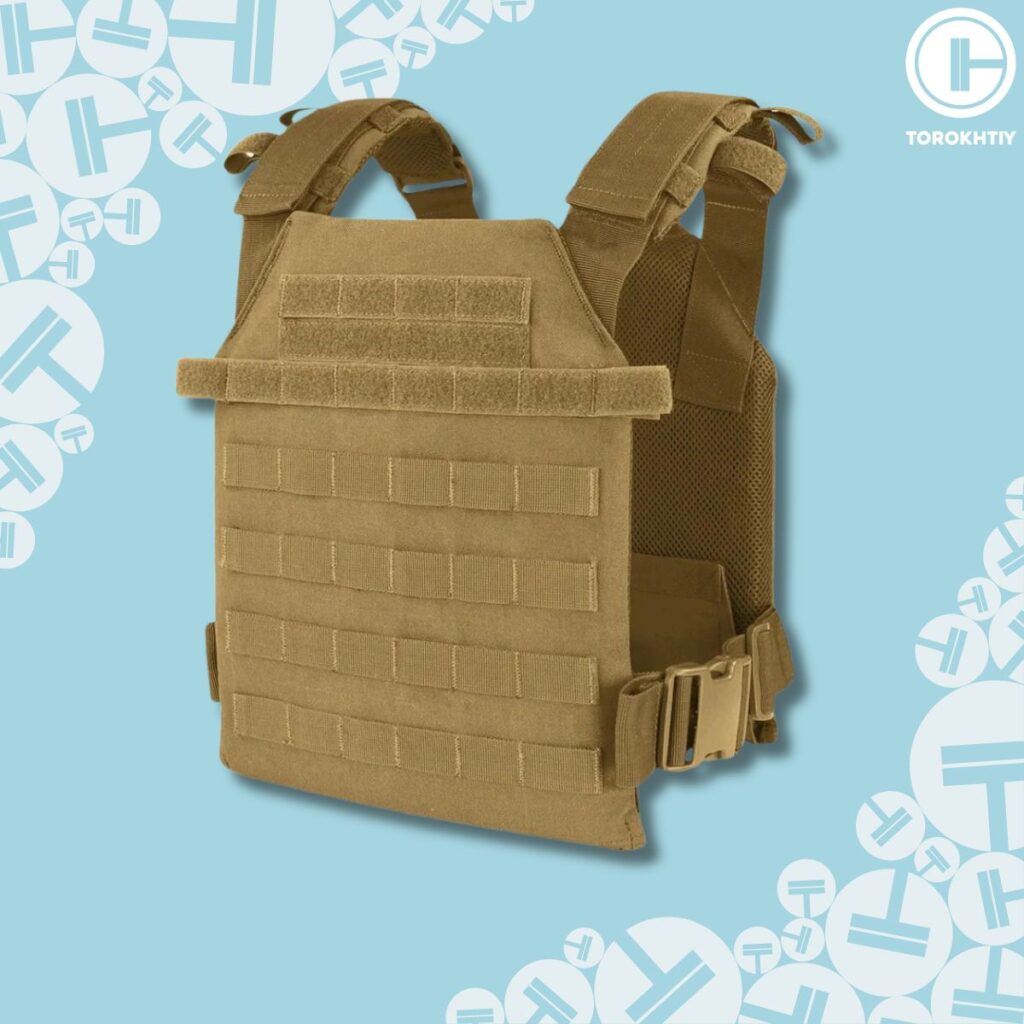


Still have questions after reading our article? Unlock your full potential by engaging with our experts and community! Don’t hesitate — leave a comment below and Ihor Shymechko will provide a personalized answer and insights to help you reach your goals.